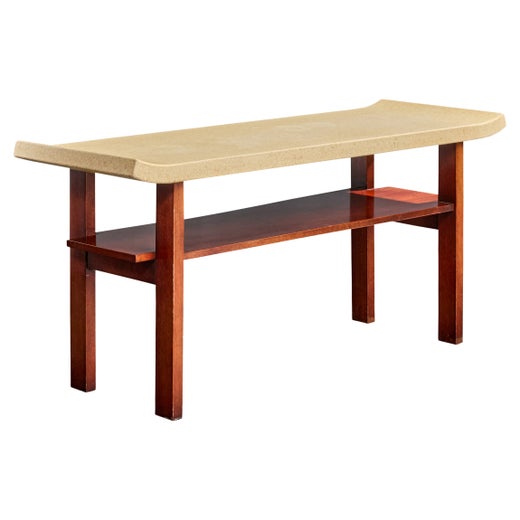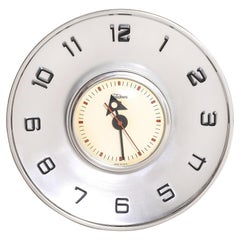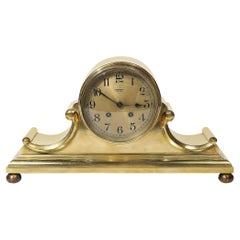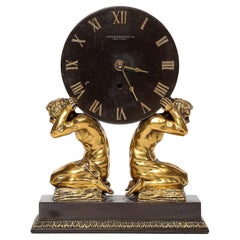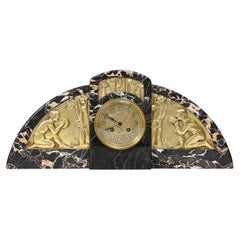"Modernique" Clock by Paul Frankl for Warren Telechron Company, circa 1928
About the Item
- Creator:Warren Telechron Co. (Maker),Paul Frankl (Designer)
- Dimensions:Height: 8 in (20.32 cm)Width: 5.75 in (14.61 cm)Depth: 5.5 in (13.97 cm)
- Style:Art Deco (Of the Period)
- Materials and Techniques:
- Place of Origin:
- Period:
- Date of Manufacture:circa 1928
- Condition:Wear consistent with age and use. Minor losses.
- Seller Location:New York, NY
- Reference Number:1stDibs: LU79349237063
Paul Frankl
Born in Vienna, Paul Frankl came to the United States in 1914 as part of a wave of Central European design luminaries — among them Kem Weber, Rudolph Schindler, and Richard Neutra — who were drawn by the energy and optimism of the American scene. Prolific and protean, Frankl would go on to design furnishings that are emblematic of nearly every key stylistic chord in American modernism, from the streamlined Art Deco to free-form organic shapes.
Frankl's Skyscraper cabinets, bookcases and more — introduced in 1924 — are his earliest and best-known designs (and the work by which he is most often represented in institutions, such as New York’s Metropolitan Museum of Art). Tall and narrow, the pieces have staggered shelves meant to mimic the setbacks of Manhattan office towers. A later visually expressive line — the Speed chairs and sofas, which have a raked profile suggesting motion — links Frankl to Donald Deskey, Raymond Loewy and other creators of Streamline Moderne design.
Frankl moved to Los Angeles in 1934 and luxuriated in the climate and lifestyle. His designs became lighter and simpler and found an audience among the Hollywood élite. (Katharine Hepburn, Cary Grant and Fred Astaire were clients.) Fascinated by Asian arts, Frankl produced numerous pieces — tabletops with edges that curve upward; sofas, chairs and other seating with rattan frames — inspired by Chinese and Japanese forms and materials. In the 1940s, Frankl became one of the first designers to incorporate free-form, biomorphic shapes in his work, as well as novel upholstery fabrics such as denim and nubby wool.
Frankl biographer Christopher Long argues that the designer’s easy, elegant aesthetic had an enormous influence on movie set design. As the furniture below attests, Paul Frankl’s work is ready for its close-up.
Find vintage Paul Frankl tables, dining chairs, case pieces and storage cabinets on 1stDibs.
You May Also Like
Vintage 1920s American Machine Age Mantel Clocks
Glass
Vintage 1920s American Mantel Clocks
Metal
Early 20th Century American Art Deco Table Clocks and Desk Clocks
Bakelite
Vintage 1930s Saint Pierre and Miquelon Art Deco Table Clocks and Desk C...
Brass
Vintage 1930s American Industrial Table Clocks and Desk Clocks
Glass, Wood
Mid-20th Century American Mid-Century Modern Table Clocks and Desk Clocks
Brass
20th Century Art Deco Mantel Clocks
Marble
Vintage 1910s English Victorian Clocks
Silver
Vintage 1940s American Table Clocks and Desk Clocks
Acrylic
Vintage 1910s English Edwardian Wall Clocks
Brass, Copper, Steel
More From This Seller
View AllVintage 1950s American Mid-Century Modern Wall Clocks
Aluminum
Vintage 1920s American Art Deco Mantel Clocks
Brass
Antique Early 1900s American Neoclassical Mantel Clocks
Bronze
Vintage 1930s French Art Deco Mantel Clocks
Marble, Brass
Vintage 1950s American Mid-Century Modern Night Stands
Nickel
Vintage 1940s American Art Deco Office Chairs and Desk Chairs
Mohair, Walnut
Still Thinking About These?
All Recently ViewedRead More
How to Work Rattan and Wicker Furniture into Any Space
Interior designers Celerie Kemble and Angie Hranowsky dish out their advice on artfully bringing these natural materials into today's homes.
20th-Century Design Shines at the High Style Deco Auction
New York furniture dealer Howard Williams not only has an eye for top-notch pieces from a range of eras but also meticulously restores them to their original glory.
